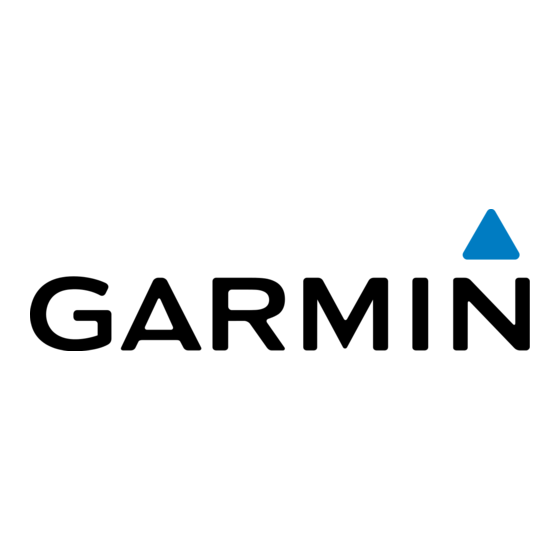

Garmin GPSMAP 450s Owner's Manual
Gpsmap 400 series
Hide thumbs
Also See for GPSMAP 450s:
- Owner's manual (72 pages) ,
- Quick reference manual (2 pages) ,
- Owner's manual (72 pages)
Table of Contents
Advertisement
Quick Links
Advertisement
Table of Contents

Summarization of Contents
INTRODUCTION
Tips and Shortcuts
Operations for quick access to functions like returning to the Home screen or accessing settings.
Manual Conventions
Explains text and symbol usage in the manual, including how to select items.
GETTING STARTED
Acquiring GPS Satellite Signals
Process for obtaining a GPS fix and establishing the unit's current location.
Using Simulator Mode
Practice navigation without actual GPS data by turning the GPS receiver off.
Restoring Factory Settings
Resets the unit to its original configuration, deleting user-entered data.
Viewing System Information
Accesses software version, basemap version, and unit ID.
Inserting and Removing SD Cards
Managing memory cards for data transfer, such as waypoints and routes.
Understanding the Home Screen
Overview of main menu options and navigation within the unit interface.
USING CHARTS
Using the Navigation Chart
Primary map view for course planning and navigation using preloaded maps.
Enabling High Resolution Satellite Imagery
Overlaying satellite images onto charts for a realistic view of land and water.
Viewing Aerial Photos
Detailed aerial views of marinas and landmarks to help orient surroundings.
Viewing Current Station Information
Data on water current speed and direction shown as a highlighted arrow icon.
Detailed Road and POI Data
Accessing land-based points of interest like roads, restaurants, and attractions.
Using Automatic Guidance
Automated route planning assistance based on chart information.
Changing the Chart Settings
Customizing map display parameters like orientation and detail level.
Using the Chart/Sonar Screen
Displaying chart and sonar data simultaneously in a split screen.
Navigation Chart Settings
Adjusting options for the navigation chart display, including orientation.
Panning the Navigation Chart
Moving the map display across the screen using the ROCKER.
WHERE TO?
Navigating to a Destination
Steps to find and follow a route to a destination using Go To, Route To, or Guide To.
Creating and Using Waypoints
Marking and managing specific locations on the chart.
Zooming In and Out on the Map
Adjusting map scale using the RANGE keys for detail.
Accessing Additional Object Information
Viewing details of map features and waypoints using the map pointer.
Viewing Tide Station Information
Tide level predictions displayed on the chart with detailed icons.
VIEWING INFORMATION
Viewing Numbers
Customizing and displaying numerical data fields like depth and GPS.
Viewing Current Information
Details on water current predictions, showing speed and direction.
Viewing Celestial Information
Sun and moon rise/set, phase, and sky view location data.
Viewing User Data
Managing waypoints, routes, and tracks, including data transfer.
Viewing Other Boats
Displaying information about nearby vessels using AIS or DSC.
CONFIGURING THE UNIT
Configuring System Settings
General unit preferences and options, including simulator and language.
Changing Units of Measure
Setting distance, speed, depth, temperature, and time units.
Configuring Communications Settings
Managing NMEA and data connections, including output sentences.
Setting Alarms
Configuring audible alerts for various conditions like anchor drag or arrival.
Setting Navigation Alarms
Alarms related to course deviation and arrival at a destination.
Setting System Alarms
Alarms for clock, battery voltage, and GPS accuracy.
Setting Sonar Alarms
Alarms for depth, water temperature, and fish detection.
Setting Weather Alarms
Alerts for weather conditions, requiring XM WX subscription.
Configuring My Boat
Settings specific to the user's boat, like safe depth and keel offset.
Configuring Other Boats
Settings for AIS and DSC for other vessels, requires external device.
USING SONAR
Understanding the Full Screen
Full-screen display of transducer's sonar readings.
Understanding the Flasher
Flasher display for instantaneous sonar return of what is below the boat.
Understanding the Split Freq Screen
Displaying 50kHz and 200kHz sonar data side-by-side.
Understanding The Split Zoom Screen
Viewing a zoomed section of the sonar display with a zoom window.
Understanding the Temp Log Screen
Graphic log of temperature readings over time from a temperature-capable transducer.
Setting Up Sonar
General sonar configuration options, including color scheme and fish symbols.
Advanced Sonar Settings
Adjusting sonar settings like range, gain, beam, and frequency.
INSTALLING THE UNIT
Step 1: Select a Location
Choosing an optimal mounting spot considering viewing and cable routing.
Step 2: Mount the Unit
Mounting the unit using the included tilt/swivel bracket.
Step 3: Install the Transducer
Installing the depth/fish finder transducer for sonar functionality.
Mounting the Transducer on a Transom
Method for mounting the transducer on the boat's transom.
Shoot-Thru-Hull Installation
Alternative method for transducer mounting inside the hull.
Selecting a Location for a Shoot-Thru-Hull Installation
Choosing a location for the shoot-thru-hull transducer based on hull material.
Step 4: Install the Wiring Harness
Connecting power and data cables to the unit.
Connecting to a NMEA device
Interfacing with other NMEA equipment, like DSC or AIS devices.
Installing the Unit to a Garmin CANet
Connecting to CANet compatible devices for data sharing.
Step 5: Test the Installation
Initial setup and testing of the installed unit to ensure proper function.
APPENDIX
Specifications
Detailed technical specifications of the unit, including dimensions and performance.
Product Registration
How to register the unit online for support and service.
Caring for the Unit
Maintenance and cleaning guidelines for the unit's casing and screen.
Alarms and Messages
Explanation of unit alerts and error messages for operating conditions.
Weather Data Warranty
Warranty terms and conditions for the weather data service.
Software License Agreement
Terms and conditions for using the embedded software.
Limited Warranty
Manufacturer's warranty policy for defects in materials or workmanship.
FCC Compliance
Regulatory information regarding FCC interference limits for Class B devices.
Industry Canada Compliance
Regulatory information for radiocommunication devices in Canada.
Declaration of Conformity (DoC)
EU conformity statement declaring compliance with essential requirements.
Optional Accessories
List of available add-on products for enhancing unit functionality.







Need help?
Do you have a question about the GPSMAP 450s and is the answer not in the manual?
Questions and answers